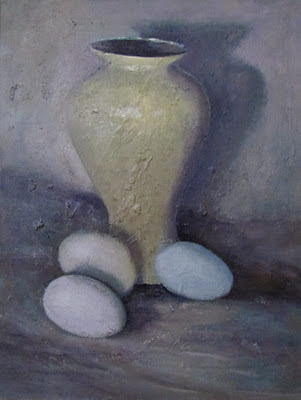My usual palette violates the rules that most experienced painters recommend. The collective wisdom of artists much more accomplished than me is that a limited palette results in a more harmonious painting. They say you only need six or eight colors to achieve the variety that you need. I have done whole paintings with limited palettes and I agree they are harmonious. Gradually I have added colors to my palette, the result of various classes and workshops with a variety of teachers. They have their favorites and teach how they use the color. Along the way, if I liked a particular color as a result of the class, I add it. This is what my palette looks like these days.
It includes:- Titanium White
- Naples Yellow
- Yellow Ochre
- Raw Sienna
- Lemon Yellow
- Cadmium Yellow Deep
- Cadmium Red Light
- Alizarin Crimson
- Permanent Rose
- Cadmium Orange
- Viridian Green
- Sap Green
- Cadmium Green Light
- Permanent Green
- Cerulean Blue
- Ultramarine Blue Deep
- Prussian Blue
- Pthallo Blue
- Dioxine Purple
- Burnt Sienna
- Van Dyke Brown
- Raw Umber
- Greenish Umber
The fact of the matter is, I don't care what the rules are. I have experimented with every one of these colors and I know what I like to use them for - and I want them ALL. So there - master of my own artistic universe.
So imagine the fright when my Friday morning teacher, Jody Regan, explained the exercise for the day. The challenge was to stay within the muted, least chromatic third of the color wheel. We were to create a low chroma still life set up, identify the highest color note, establish that note on the canvas, then complete the painting keeping every other stroke at a "sub-chroma" level to the initial color note.
Given what I described above about me and color, maybe you get an idea of how difficult this was. I declare this the hardest class exercise I have ever done.
Another classmate had brought some fresh eggs from his chickens, that happened to be very pale shades of pink or green, beautiful and perfect for the challenge. A pale yellow-green vase was placed behind the three eggs. To me, the vase was the highest chroma, so I applied a stripe of yellow, which was to become my chroma level baseline for the rest of the painting. I decided on an ochre-purple gray as my dominant mixing color throughout the rest of the painting.
 I found by forcing a limit on the brightness, I expanded my range of color into an area that I wasn't intuitively apt to use. I immediately have reaped a benefit from the exercise as I am working on two enormous snowscapes. I'll talk about those another day.
I found by forcing a limit on the brightness, I expanded my range of color into an area that I wasn't intuitively apt to use. I immediately have reaped a benefit from the exercise as I am working on two enormous snowscapes. I'll talk about those another day.I recommend this exercise for those painters - like me - who tend to pump up the color. Ironically, it is an expansion of my color roster, a gray for mostly of the twenty three colors listed above. The more colors, the better.

No comments:
Post a Comment